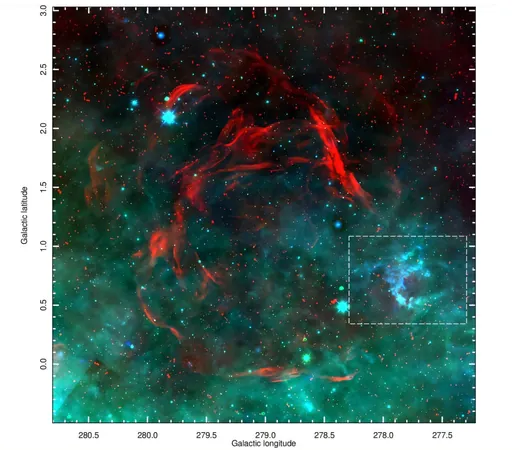
Astronomers Discover Massive Supernova Remnant Closer Than Ever Before: Meet "Diprotodon"!
2025-01-07
Author: Nur
Introduction
In an exciting breakthrough, an international team of astronomers has unveiled new findings about a massive Galactic supernova remnant known as G278.94+1.35, dramatically altering our understanding of its properties and location. The results of their research, published recently on the pre-print server arXiv, provide profound insights into this celestial phenomenon.
What are Supernova Remnants?
Supernova remnants (SNRs) are expansive structures formed from the remnants of a star that has exploded. These remnants, which consist of expelled material along with interstellar matter collected by the shockwave of the explosion, serve as crucial indicators in the study of stellar evolution and the lifecycle of galaxies.
Discovery and Characteristics of G278.94+1.35
Initially discovered in 1988, G278.94+1.35 has an estimated linear diameter of approximately 320 light years and is believed to be around 1 million years old. However, the newly published study reveals that this supernova remnant is much closer than previously thought—at just about 3,300 light years from Earth, as opposed to earlier estimates of 8,800 light years. This nearer proximity also suggests a smaller physical size for G278.94+1.35, now thought to be around 189 by 182 light years.
The Name 'Diprotodon' and Its Significance
The research was spearheaded by Miroslav D. Filipović from Western Sydney University, utilizing the advanced capabilities of the Australian Square Kilometer Array Pathfinder (ASKAP) as part of the ASKAP-Evolutionary Map of the Universe (EMU) project. During the investigation, the team serendipitously identified this large-scale object, which will now carry the name "Diprotodon," a nod to an extinct genus of Australian marsupial resembling a giant wombat from the Pleistocene era.
Why 'Diprotodon'?
Astronomers have named it Diprotodon not just for its size but also to raise awareness about Australia’s prehistoric megafauna and the concerning current extinction rates of numerous species on the continent. Given that Diprotodon is potentially among the largest supernova remnants known, the comparison to the gigantic wombat is particularly fitting.
Current Phase and Characteristics of Diprotodon
The study reveals that Diprotodon is currently in its radiative evolutionary phase and retains an almost circular shape, indicating it is still expanding. The progenitor mass of this remnant is estimated at around 15 solar masses, with its kinetic energy reaching up to 500 quindecillion ergs—a staggering figure that emphasizes the power behind supernova explosions. The spectral index of Diprotodon is measured at approximately -0.55, a characteristic figure consistent with the average shell-type SNRs observed in the Milky Way.
Conclusion
The newfound knowledge about Diprotodon not only enhances our understanding of this remarkable cosmic structure but also serves as a reminder of the dynamic processes that shape our universe. Astronomers are optimistic that these findings will further illuminate the study of stellar evolution and the history of our galaxy. Stay tuned as we continue to unravel the secrets of space!
 Brasil (PT)
Brasil (PT)
 Canada (EN)
Canada (EN)
 Chile (ES)
Chile (ES)
 Česko (CS)
Česko (CS)
 대한민국 (KO)
대한민국 (KO)
 España (ES)
España (ES)
 France (FR)
France (FR)
 Hong Kong (EN)
Hong Kong (EN)
 Italia (IT)
Italia (IT)
 日本 (JA)
日本 (JA)
 Magyarország (HU)
Magyarország (HU)
 Norge (NO)
Norge (NO)
 Polska (PL)
Polska (PL)
 Schweiz (DE)
Schweiz (DE)
 Singapore (EN)
Singapore (EN)
 Sverige (SV)
Sverige (SV)
 Suomi (FI)
Suomi (FI)
 Türkiye (TR)
Türkiye (TR)
 الإمارات العربية المتحدة (AR)
الإمارات العربية المتحدة (AR)